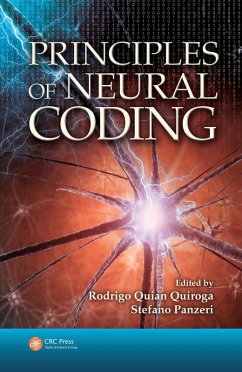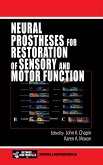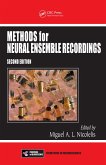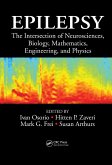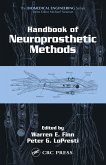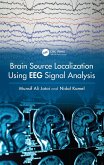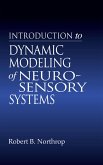Principles of Neural Coding (eBook, PDF)
Redaktion: Quiroga, Rodrigo Quian; Panzeri, Stefano
177,95 €
177,95 €
inkl. MwSt.
Sofort per Download lieferbar

89 °P sammeln
177,95 €
Als Download kaufen

177,95 €
inkl. MwSt.
Sofort per Download lieferbar

89 °P sammeln
Jetzt verschenken
Alle Infos zum eBook verschenken
177,95 €
inkl. MwSt.
Sofort per Download lieferbar
Alle Infos zum eBook verschenken

89 °P sammeln
Principles of Neural Coding (eBook, PDF)
Redaktion: Quiroga, Rodrigo Quian; Panzeri, Stefano
- Format: PDF
- Merkliste
- Auf die Merkliste
- Bewerten Bewerten
- Teilen
- Produkt teilen
- Produkterinnerung
- Produkterinnerung

Bitte loggen Sie sich zunächst in Ihr Kundenkonto ein oder registrieren Sie sich bei
bücher.de, um das eBook-Abo tolino select nutzen zu können.
Hier können Sie sich einloggen
Hier können Sie sich einloggen
Sie sind bereits eingeloggt. Klicken Sie auf 2. tolino select Abo, um fortzufahren.

Bitte loggen Sie sich zunächst in Ihr Kundenkonto ein oder registrieren Sie sich bei bücher.de, um das eBook-Abo tolino select nutzen zu können.
Understanding how populations of neurons encode information is the challenge faced by researchers in the field of neural coding. Focusing on the many mysteries and marvels of the mind has prompted a prominent team of experts in the field to put their heads together and fire up a book on the subject. Simply titled Principles of Neural Coding, this b
- Geräte: PC
- mit Kopierschutz
- eBook Hilfe
- Größe: 35.27MB
Andere Kunden interessierten sich auch für
![Neural Prostheses for Restoration of Sensory and Motor Function (eBook, PDF) Neural Prostheses for Restoration of Sensory and Motor Function (eBook, PDF)]() Neural Prostheses for Restoration of Sensory and Motor Function (eBook, PDF)63,95 €
Neural Prostheses for Restoration of Sensory and Motor Function (eBook, PDF)63,95 €![Indwelling Neural Implants (eBook, PDF) Indwelling Neural Implants (eBook, PDF)]() Indwelling Neural Implants (eBook, PDF)63,95 €
Indwelling Neural Implants (eBook, PDF)63,95 €![Methods for Neural Ensemble Recordings (eBook, PDF) Methods for Neural Ensemble Recordings (eBook, PDF)]() Methods for Neural Ensemble Recordings (eBook, PDF)186,95 €
Methods for Neural Ensemble Recordings (eBook, PDF)186,95 €![Epilepsy (eBook, PDF) Epilepsy (eBook, PDF)]() Epilepsy (eBook, PDF)103,95 €
Epilepsy (eBook, PDF)103,95 €![Handbook of Neuroprosthetic Methods (eBook, PDF) Handbook of Neuroprosthetic Methods (eBook, PDF)]() Handbook of Neuroprosthetic Methods (eBook, PDF)64,95 €
Handbook of Neuroprosthetic Methods (eBook, PDF)64,95 €![Brain Source Localization Using EEG Signal Analysis (eBook, PDF) Brain Source Localization Using EEG Signal Analysis (eBook, PDF)]() Munsif Ali JatoiBrain Source Localization Using EEG Signal Analysis (eBook, PDF)58,95 €
Munsif Ali JatoiBrain Source Localization Using EEG Signal Analysis (eBook, PDF)58,95 €![Introduction to Dynamic Modeling of Neuro-Sensory Systems (eBook, PDF) Introduction to Dynamic Modeling of Neuro-Sensory Systems (eBook, PDF)]() Robert B. NorthropIntroduction to Dynamic Modeling of Neuro-Sensory Systems (eBook, PDF)211,95 €
Robert B. NorthropIntroduction to Dynamic Modeling of Neuro-Sensory Systems (eBook, PDF)211,95 €-
-
-
Understanding how populations of neurons encode information is the challenge faced by researchers in the field of neural coding. Focusing on the many mysteries and marvels of the mind has prompted a prominent team of experts in the field to put their heads together and fire up a book on the subject. Simply titled Principles of Neural Coding, this b
Dieser Download kann aus rechtlichen Gründen nur mit Rechnungsadresse in A, B, BG, CY, CZ, D, DK, EW, E, FIN, F, GR, HR, H, IRL, I, LT, L, LR, M, NL, PL, P, R, S, SLO, SK ausgeliefert werden.
Produktdetails
- Produktdetails
- Verlag: Taylor & Francis eBooks
- Seitenzahl: 663
- Erscheinungstermin: 6. Mai 2013
- Englisch
- ISBN-13: 9781439853313
- Artikelnr.: 39175447
- Verlag: Taylor & Francis eBooks
- Seitenzahl: 663
- Erscheinungstermin: 6. Mai 2013
- Englisch
- ISBN-13: 9781439853313
- Artikelnr.: 39175447
- Herstellerkennzeichnung Die Herstellerinformationen sind derzeit nicht verfügbar.
Rodrigo Quian Quiroga is a neuroscientist at the University of Leicester UK. He holds a research chair and is the director of the Centre for Systems Neuroscience and the head of the Bioengineering Research Group at the University of Leicester. In 2010, he obtained the Royal Society Wolfson Research Merit Award. His main research interest is on the study of the principles of visual perception and memory. Together with colleagues at Caltech and UCLA, he discovered what has been named "Concept cells" or "Jennifer Aniston neurons"-neurons in the human brain that play a key role in memory formation. Stefano Panzeri received a Laurea in Physics from the University of Torino, and a PhD in computational neuroscience from SISSA, Trieste, Italy. He has held personal research fellowship awards in theoretical physics and computational neuroscience, including an INFN Junior Fellowship in Theoretical Physics at Turin University, an EU Marie Curie Postdoctoral Fellowship at the University of Oxford, and an MRC Research Fellowship in Neuroinformatics at the University of Newcastle. He has worked as senior scientist at the Italian Institute of Technology since 2007 and as chair in the Formal Analysis of Cortical Networks at the University of Glasgow since 2012.
Section I Methods. Physiological Foundations of Neural Signals. Biophysics
of Extracellular Spikes. Local Field Potentials: Biophysical Origin and
Analysis. Spike Sorting. Spike-Train Analysis. Synchronization Measures.
Role of Correlations in Population Coding. Decoding and Information Theory
in Neuroscience. Section II Experimental Results. Neural Coding of Visual
Objects. Coding in the Auditory System. Coding in the Whisker Sensory
System. Neural Coding in the Olfactory System. Coding across Sensory
Modalities: Integrating the Dynamic Face with the Voice. Population Coding
by Place Cells and Grid Cells. Coding of Movement Intentions. Neural Coding
of Short-Term Memory. Role of Temporal Spike Patterns in Neural Codes.
Adaptation and Sensory Coding. Sparse and Explicit Neural Coding.
Information Coding by Cortical Populations. Information Content of Local
Field Potentials: Experiments and Models. Principles of Neural Coding from
EEG Signals. Gamma-Band Synchronization and Information Transmission.
Decoding Information from fMRI Signals. Section III Theoretical and In
Silico Approaches. Dynamics of Neural Networks. Learning and Coding in
Neural Networks. Ising Models for Inferring Network Structure from Spike
Data. Vocal Learning with Inverse Models. Computational Models of Visual
Object Recognition. Coding in Neuromorphic VLSI Networks. Open-Source
Software for Studying Neural Codes. Index.
of Extracellular Spikes. Local Field Potentials: Biophysical Origin and
Analysis. Spike Sorting. Spike-Train Analysis. Synchronization Measures.
Role of Correlations in Population Coding. Decoding and Information Theory
in Neuroscience. Section II Experimental Results. Neural Coding of Visual
Objects. Coding in the Auditory System. Coding in the Whisker Sensory
System. Neural Coding in the Olfactory System. Coding across Sensory
Modalities: Integrating the Dynamic Face with the Voice. Population Coding
by Place Cells and Grid Cells. Coding of Movement Intentions. Neural Coding
of Short-Term Memory. Role of Temporal Spike Patterns in Neural Codes.
Adaptation and Sensory Coding. Sparse and Explicit Neural Coding.
Information Coding by Cortical Populations. Information Content of Local
Field Potentials: Experiments and Models. Principles of Neural Coding from
EEG Signals. Gamma-Band Synchronization and Information Transmission.
Decoding Information from fMRI Signals. Section III Theoretical and In
Silico Approaches. Dynamics of Neural Networks. Learning and Coding in
Neural Networks. Ising Models for Inferring Network Structure from Spike
Data. Vocal Learning with Inverse Models. Computational Models of Visual
Object Recognition. Coding in Neuromorphic VLSI Networks. Open-Source
Software for Studying Neural Codes. Index.
Section I Methods. Physiological Foundations of Neural Signals. Biophysics
of Extracellular Spikes. Local Field Potentials: Biophysical Origin and
Analysis. Spike Sorting. Spike-Train Analysis. Synchronization Measures.
Role of Correlations in Population Coding. Decoding and Information Theory
in Neuroscience. Section II Experimental Results. Neural Coding of Visual
Objects. Coding in the Auditory System. Coding in the Whisker Sensory
System. Neural Coding in the Olfactory System. Coding across Sensory
Modalities: Integrating the Dynamic Face with the Voice. Population Coding
by Place Cells and Grid Cells. Coding of Movement Intentions. Neural Coding
of Short-Term Memory. Role of Temporal Spike Patterns in Neural Codes.
Adaptation and Sensory Coding. Sparse and Explicit Neural Coding.
Information Coding by Cortical Populations. Information Content of Local
Field Potentials: Experiments and Models. Principles of Neural Coding from
EEG Signals. Gamma-Band Synchronization and Information Transmission.
Decoding Information from fMRI Signals. Section III Theoretical and In
Silico Approaches. Dynamics of Neural Networks. Learning and Coding in
Neural Networks. Ising Models for Inferring Network Structure from Spike
Data. Vocal Learning with Inverse Models. Computational Models of Visual
Object Recognition. Coding in Neuromorphic VLSI Networks. Open-Source
Software for Studying Neural Codes. Index.
of Extracellular Spikes. Local Field Potentials: Biophysical Origin and
Analysis. Spike Sorting. Spike-Train Analysis. Synchronization Measures.
Role of Correlations in Population Coding. Decoding and Information Theory
in Neuroscience. Section II Experimental Results. Neural Coding of Visual
Objects. Coding in the Auditory System. Coding in the Whisker Sensory
System. Neural Coding in the Olfactory System. Coding across Sensory
Modalities: Integrating the Dynamic Face with the Voice. Population Coding
by Place Cells and Grid Cells. Coding of Movement Intentions. Neural Coding
of Short-Term Memory. Role of Temporal Spike Patterns in Neural Codes.
Adaptation and Sensory Coding. Sparse and Explicit Neural Coding.
Information Coding by Cortical Populations. Information Content of Local
Field Potentials: Experiments and Models. Principles of Neural Coding from
EEG Signals. Gamma-Band Synchronization and Information Transmission.
Decoding Information from fMRI Signals. Section III Theoretical and In
Silico Approaches. Dynamics of Neural Networks. Learning and Coding in
Neural Networks. Ising Models for Inferring Network Structure from Spike
Data. Vocal Learning with Inverse Models. Computational Models of Visual
Object Recognition. Coding in Neuromorphic VLSI Networks. Open-Source
Software for Studying Neural Codes. Index.
